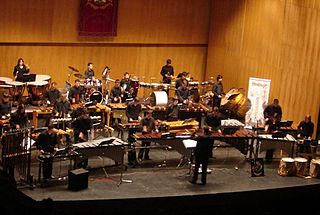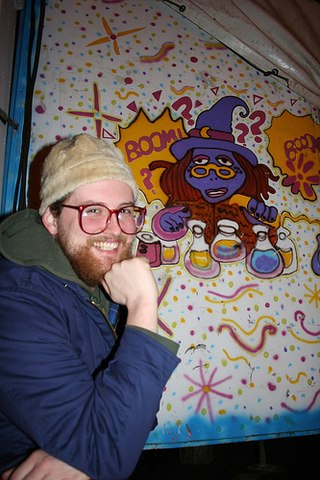
John Milton Cage Jr. was an American composer and music theorist. A pioneer of indeterminacy in music, electroacoustic music, and non-standard use of musical instruments, Cage was one of the leading figures of the post-war avant-garde. Critics have lauded him as one of the most influential composers of the 20th century. He was also instrumental in the development of modern dance, mostly through his association with choreographer Merce Cunningham, who was also Cage's romantic partner for most of their lives.

Anthony Braxton is an American experimental composer, educator, music theorist, improviser and multi-instrumentalist who is best known for playing saxophones, particularly the alto. Braxton grew up on the South Side of Chicago, Illinois, and was a key early member of the Association for the Advancement of Creative Musicians. He received great acclaim for his 1969 double-LP record For Alto, the first full-length album of solo saxophone music.

4′33″ is a modernist composition by American experimental composer John Cage. It was composed in 1952 for any instrument or combination of instruments; the score instructs performers not to play their instruments throughout the three movements. It is divided into three movements, lasting 30 seconds, two minutes and 23 seconds, and one minute and 40 seconds, respectively, although Cage later stated that the movements' durations can be determined by the musician. As indicated by the title, the composition lasts four minutes and 33 seconds and is marked by a period of silence, although ambient sounds contribute to the performance.

Annie Gosfield is a New-York-based composer who works on the boundaries between notated and improvised music, electronic and acoustic sounds, refined timbres and noise. She composes for others and performs with her own group, taking her music to festivals, factories, clubs, art spaces and concert halls. Much of her work combines acoustic instruments with electronic sounds, incorporating unusual sources such as satellite sounds, machine sounds, detuned or out-of-tune samples and industrial noises. Her work often contains improvisation and frequently uses extended techniques and/or altered musical instruments. She won a 2012 Berlin Prize.

A percussion ensemble is a musical ensemble consisting of only percussion instruments. Although the term can be used to describe any such group, it commonly refers to groups of classically trained percussionists performing primarily classical music. In America, percussion ensembles are most commonly found at conservatories, though some professional groups, such as Nexus and So Percussion exist. Drumlines and groups who regularly meet for drum circles are two other forms of the percussion ensemble.
Howard While Skempton is an English composer, pianist, and accordionist.

Steve Reich and Musicians, sometimes credited as the Steve Reich Ensemble, is a musical ensemble founded and led by the American composer Steve Reich. The group has premiered and performed many of Reich's works both nationally and internationally. In 1999, Reich received a Grammy Award for "Best Small Ensemble Performance " for the ensemble's performance of Music for 18 Musicians.

Daniel Deacon is an American composer and electronic musician based in Baltimore, Maryland.
Credo in Us is a musical composition by the American experimental music composer, writer and visual artist John Cage. It was written in July 1942 and revised in October of that year. In the wake of Pearl Harbor, this piece avoided the populist tendencies of fellow American composers at the time, while the piece's title is thought to be a call to collective unity.
Music of Changes is a piece for solo piano by John Cage. Composed in 1951 for pianist and friend David Tudor, it is a ground-breaking piece of indeterminate music. The process of composition involved applying decisions made using the I Ching, a Chinese classic text that is commonly used as a divination system. The I Ching was applied to large charts of sounds, durations, dynamics, tempo and densities.

Sō Percussion is an American percussion quartet formed in 1999 and based in New York City.
Construction is the title of several pieces by American composer John Cage, all scored for unorthodox percussion instruments. The pieces were composed in 1939–42 while Cage was working at the Cornish School of the Arts in Seattle, Washington, and touring the West Coast with a percussion ensemble he and Lou Harrison had founded. The series comprises three Constructions. A piece titled Fourth Construction, mentioned in several sources, is apparently either an unfinished work from 1942 or, more likely, an early title of the work we now know as Imaginary Landscape No. 2 .

Imaginary Landscape No. 1 is a composition for records of constant and variable frequency, large chinese cymbal and string piano by American composer John Cage and the first in the series of Imaginary Landscapes. It was composed in 1939.
Live electronic music is a form of music that can include traditional electronic sound-generating devices, modified electric musical instruments, hacked sound generating technologies, and computers. Initially the practice developed in reaction to sound-based composition for fixed media such as musique concrète, electronic music and early computer music. Musical improvisation often plays a large role in the performance of this music. The timbres of various sounds may be transformed extensively using devices such as amplifiers, filters, ring modulators and other forms of circuitry. Real-time generation and manipulation of audio using live coding is now commonplace.

Imaginary Landscape No. 3 is a composition for six percussionists by American composer John Cage and the third in the series of Imaginary Landscapes. It is the last Imaginary Landscape to feature percussion instruments and, therefore, the last one to be considered a chamber piece. It was composed in 1942.

Imaginary Landscape No. 2 is a composition for five percussionists by American composer John Cage and the second in the series of Imaginary Landscapes. It was also the first march in the set, the second being Imaginary Landscape No. 4 . It was composed in 1942.

Jan Williams is a percussionist, arts administrator, teacher, conductor, and composer who has championed avant-garde and progressive music in the United States. He is recognized as an important proponent of percussion performance and its literature.
But What About the Noise of Crumpling Paper Which He Used to Do in Order to Paint the Series of "Papiers Froissés" Or Tearing Up Paper to Make "Papiers Déchirés?" Arp Was Stimulated by Water, Forests, sometimes shortened as But What About the Noise ..., is a composition for percussion ensemble by American composer John Cage. It was finished in 1985.

Imaginary Landscape No. 5 is a composition by American composer John Cage and the fifth and final installment in the series of Imaginary Landscapes. It was composed in 1952.









